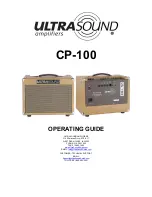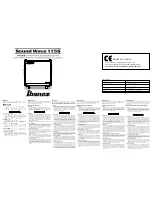
ser direkt mit der Minusklemme der Autobatterie ver-
binden. Hinweise:
1. Bei Verwendung der Karosserie als Massean-
schluss muss die verwendete Stelle einen guten
elektrischen Kontakt zur Hauptkarosserie aufwei-
sen (z. B. durch ausreichend viele Schweiß-
punkte). Eventueller Lack am Kontaktpunkt muss
vollständig entfernt werden.
2. Zur Vermeidung von Masseschleifen muss die
Masse des Autoradios an die Stelle gelegt wer-
den, an der auch die Endstufe an Masse liegt.
6.1.3 Steuerspannung zum Einschalten
Die Car-HiFi-Endstufe wird durch eine Steuerspan-
nung von +12 V am Anschluss REM (12) ein- und
ausgeschaltet. Den Anschluss REM mit dem 12-V-
Schaltausgang vom Autoradio verbinden (Anschluss
für eine Motorantenne, eventuell mit der Motoran-
tenne parallel schalten).
6.2 Eingänge
Die beiden Eingangsbuchsen LINE IN (9) über
Cinch-Kabel mit den entsprechenden Line-Ausgän-
gen am Autoradio verbinden (Abb. 3). Sind am Auto-
radio keine Line-Ausgänge vorhanden, alternativ die
Lautsprecherausgänge des Autoradios mit den Ein-
gängen HIGH INPUT (8) verbinden. Dazu das bei-
liegende 3-polige Adapterkabel verwenden:
linker Kontakt R+
rechter Kanal
mittlerer Kontakt GND Masse am Autoradio (nicht
am Lautsprecherausgang L-
oder R- anschließen!)
rechter Kontakt L+
linker Kanal
Soll die Endstufe im Brückenbetrieb einen Lautspre-
cher für den rechten
oder
linken Kanal antreiben,
beide Eingänge LINE IN gemeinsam über ein Y-
Kabel (z. B. CBA-25/SW von CARPOWER) mit dem
Line-Ausgang des rechten bzw. linken Kanals am
Autoradio verbinden – siehe auch Abb. 4. Wird im
Brückenbetrieb jedoch ein Mono-Subwoofer ange-
trieben, den linken und den rechten Kanal, wie in
Abb. 3 dargestellt, ohne Y-Kabel anschließen.
6.3 Line-Ausgänge
An die Ausgänge LINE OUT (10) lassen sich die
Eingänge eines zweiten Verstärkers anschließen
(Abb. 5), um z. B. ein 2-Wege-Aktivsystem mit Mit-
telhochtönern und Kickbasslautsprechern oder
einem Subwoofer zu realisieren (Bi-Amping). Das
Ausgangssignal an den Buchsen LINE OUT ent-
spricht dem Eingangssignal der Buchsen LINE IN (9),
durchläuft jedoch das mit dem Betriebsartenschalter
MODE (5) gewählte Filter. Die folgenden Schalter-
stellungen beziehen sich auf die Beschriftung
unter
dem Schalter:
BP
Bandpass für die Ausgänge LINE OUT einge-
schaltet: zum Anschluss eines Verstärkers für
Kickbasslautsprecher
HP
Hochpass für die Ausgänge eingeschaltet:
zum Anschluss eines Verstärkers für Mittel-
hochtöner
LP
Tiefpass für die Ausgänge eingeschaltet: zum
Anschluss eines Verstärkers für Basslaut-
sprecher oder eines Subwoofer-Verstärkers
FULL kein Filter eingeschaltet: zum Anschluss eines
Verstärkers für Full-Range-Lautsprecher
Der erste Verstärker kann z. B. die Mittelhochtöner
antreiben und liefert die Bässe an seinen Line-Aus-
gängen (Schalterstellung AMP HP/LINE OUT LP)
für den zweiten Verstärker, der die Basslautsprecher
bzw. einen Subwoofer antreibt.
6.4 Lautsprecher
Es lassen sich Full-Range-Lautsprecher (2- oder 3-
Wege-Lautsprecher), Mittelhochtöner, Basslaut-
sprecher oder ein Subwoofer betreiben. Im 2-Kanal-
betrieb kann die Endstufe die Lautsprecher für den
linken und rechten Kanal antreiben oder im
Brückenbetrieb mit erhöhter Ausgangsleistung den
Lautsprecher für einen Kanal oder einen Subwoofer.
6.4.1 2-Kanalbetrieb
Die größte Ausgangsleistung wird beim Anschluss
von 2-
Ω
-Lautsprechern oder einer Lautsprecher-
gruppe mit einer Gesamtimpedanz von 2
Ω
pro
Kanal erreicht (z. B. zwei 4-
Ω
-Lautsprecher parallel
geschaltet). Es können jedoch auch einzelne 4-
Ω
-
Lautsprecher angeschlossen werden, wobei sich die
Ausgangsleistung etwas verringert. Die Lautspre-
cher an die Klemmen SPEAKER (15) anschließen –
siehe auch Abb. 3:
L+ = Pluspol
linker Lautsprecher
L- = Minuspol linker Lautsprecher
R+ = Pluspol
rechter Lautsprecher
R- = Minuspol rechter Lautsprecher
6.4.2 Brückenbetrieb
Im Brückenbetrieb darf die Impedanz des ange-
schlossenen Lautsprechers bzw. die Gesamtimpe-
danz einer Lautsprechergruppe 4
Ω
nicht unter-
schreiten! Den Lautsprecher an die Klemmen
SPEAKER (15) anschließen. Dabei die Beschriftung
BRIDGE beachten – siehe auch Abb. 4:
L+ = Pluspol
L- = bleibt frei
R+ = bleibt frei
R- = Minuspol
6.4.3 Tri-Mode
Im Tri-Mode werden ein Subwoofer im gebrückten
Monobetrieb und zwei Mittelhochtöner im 2-Kanal-
betrieb angetrieben. Hierzu ist eine geeignete
Tri-Mode-Weiche erforderlich und die Impedanz des
Subwoofers darf 4
Ω
nicht unterschreiten! Die Laut-
sprecher über eine geeignete Weiche an die Klem-
men SPEAKER (15) anschließen:
deren mechanische und elektrische Belastbarkeit
im Zusammenhang mit der genutzten Endstufen-
leistung berücksichtigen (siehe auch technische
Daten der Endstufe auf Seite 8).
Wichtig!
Alle Lautsprecher müssen 2-polig angeschlossen
werden, d. h.
ohne
gemeinsamen Masseanschluss.
Bei der Auswahl geeigneter Lautsprecher unbedingt
6.1.2 Ground connection
Connect the ground terminal GND (11) via a cable
with a minimum cross section of 10 mm
2
(e. g. CPC-
100/SW by CARPOWER*) to the ground of the car
or better directly to the negative terminal of the car
battery. Notes:
1. When using the chassis as a ground connection,
the place used must have a good electrical
contact to the main chassis (e. g. by a sufficient
number of welding points). Any lacquer at the
point of contact must completely be removed.
2. To prevent ground loops, the ground of the car
radio must be applied at the place where also the
power amplifier is grounded.
6.1.3 Control voltage for switching-on
The car HiFi power amplifier is switched on and off
by a control voltage of +12 V at the terminal REM
(12). Connect the terminal REM to the 12 V control
output of the car radio (connection for a motor
antenna, if necessary, to be connected in parallel to
the motor antenna).
6.2 Inputs
Connect both input jacks LINE IN (9) via a cable with
phono connectors to the corresponding line outputs of
the car radio (fig. 3). If no line outputs are provided at
the car radio, alternatively connect the speaker out-
puts of the car radio to the inputs HIGH INPUT (8). For
this purpose use the supplied 3-pole adapter cable:
left contact R+
right channel
central contact GND ground at the car radio (do
not connect to the speaker
output L- or R-!)
right contact L+
left channel
If the power amplifier in bridge operation is to drive a
speaker for the right channel
or
left channel, con-
nect both inputs LINE IN together via a Y cable (e. g.
CBA-25/SW by CARPOWER) to the line output of
the right or left channel at the car radio – also see
fig. 4. However, if a mono subwoofer is driven in
bridge operation, connect the left and the right chan-
nels without Y cable, as shown in fig. 3.
6.3 Line outputs
To the outputs LINE OUT (10) the inputs of a second
amplifier can be connected (fig. 5) to realize e. g. a
2-way active system with mid-high range speakers
and kick bass speakers or a subwoofer (bi-amping).
The output signal at the jacks LINE OUT corre-
sponds to the input signal of the jacks LINE IN (9),
however, passes through the filter selected with the
operating mode switch MODE (5). The following
switch positions refer to the lettering
below
the
switch.
BP
band pass for the outputs LINE OUT switched
on: for connection of an amplifier for kick bass
speakers
HP
high pass for the outputs switched on: for
connection of an amplifier for mid-high range
speakers
LP
low pass for the outputs switched on: for
connection of an amplifier for bass speakers
or a subwoofer amplifier
FULL no filter switched on: for connection of an
amplifier for full range speakers
The first amplifier can e. g. drive the mid-high range
speakers and supplies the bass frequencies to its
line outputs (switch position AMP HP/LINE OUT LP)
for the second amplifier which drives the bass
speakers or a subwoofer.
6.4 Speakers
It is possible to use full range speakers (2-way or 3-
way speakers), mid-high range speakers, bass
speakers or a subwoofer. In 2-channel operation the
power amplifier can drive the speakers for the left
channel and the right channel or in bridge operation
with increased output power it can drive the speaker
for one channel or a subwoofer.
6.4.1 2-channel operation
The highest output power is reached when connect-
ing 2
Ω
speakers or a speaker group with a total
impedance of 2
Ω
per channel (e. g. two 4
Ω
speak-
ers connected in parallel). However, it is also possi-
ble to connect individual 4
Ω
speakers in which case
the output power is slightly reduced. Connect the
speakers to the terminals SPEAKER (15) – also see
fig. 3:
L+ = positive pole
left speaker
L- = negative pole
left speaker
R+ = positive pole
right speaker
R- = negative pole
right speaker
6.4.2 Bridge operation
In bridge operation the impedance of the connected
speaker or the total impedance of a speaker group
must not be lower than 4
Ω
! Connect the speaker to
the terminals SPEAKER (15) and pay attention to
the lettering BRIDGE – also see fig. 4:
L+ = positive pole
L- = remains unconnected
R+ = remains unconnected
R- = negative pole
6.4.3 Tri-mode
In the tri-mode, a subwoofer in bridged mono opera-
tion and two mid-high range speakers in 2-channel
operation are driven. For this purpose a suitable tri-
mode crossover network is necessary, and the
impedance of the subwoofer must not be lower than
4
Ω
! Connect the speakers via a suitable crossover
network to the terminals SPEAKER (15):
connection with the applied power of the power
amplifier (also see specifications of the power
amplifier on page 8).
Important!
All speakers must be connected with 2 poles, i.e.
without
common ground connection. When
choosing suitable speakers, pay in any case atten-
tion to their mechanical and electrical capability in
6
GB
D
A
CH







































